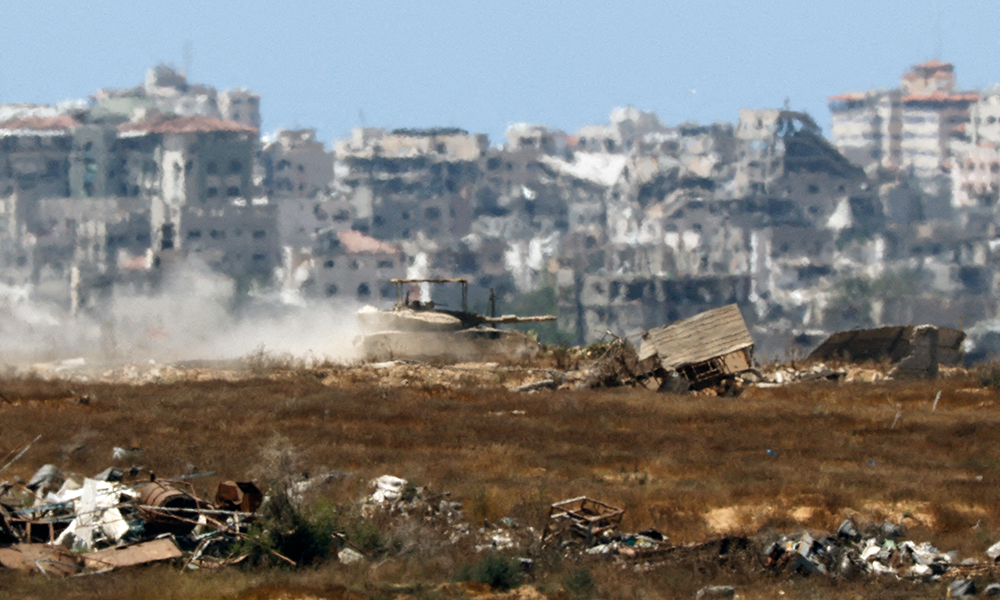Climate Change
Gaza conflict has caused major environmental damage, UN says
Gaza’s environment was already suffering from recurring conflicts, rapid urban growth, and high population density, before the most recent conflict began on Oct. 7.

The conflict in Gaza has created unprecedented soil, water and air pollution in the region, destroying sanitation systems and leaving tons of debris from explosive devices, a United Nations report on the environmental impact of the war said on Tuesday.
The war between Israel and Hamas, the Islamist movement that controls the Gaza Strip, has swiftly reversed limited progress in improving the region’s water desalination and wastewater treatment facilities, restoring the Wadi Gaza coastal wetland, and investments in solar power installations, according to a preliminary assessment, opens new tab from the U.N. Environment Programme (UNEP).
Explosive weapons have generated some 39 million tons of debris, the report said. Each square metre of the Gaza Strip is now littered with more than 107 kilograms (236 lbs) of debris. That is more than five times the debris generated during the battle for Mosul, Iraq, in 2017, the report said.
“All of this is deeply harming people’s health, food security and Gaza’s resilience,” said UNEP Executive Director Inger Andersen.
Gaza’s environment was already suffering from recurring conflicts, rapid urban growth, and high population density, before the most recent conflict began on Oct. 7.
The U.N. assessment adds to concerns about the unfolding humanitarian crisis and the environmental costs of war, with Ukraine also recording widespread ecological damage over the past two years.
“Understanding the environmental impacts of war is a grand challenge of our time,” said Eoghan Darbyshire, a senior researcher at the UK-based nonprofit Conflict and Environment Observatory. “The impacts will not only be felt locally where the fighting is taking place, but may be displaced or even felt at the global scale via greenhouse gas emissions.”
BASIC SANITATION SYSTEMS DESTROYED
The U.N. assessment stems from a December 2023 request from the Palestinian Environment Quality Authority for UNEP to take stock of environmental damages. UNEP is mandated to assist countries with pollution mitigation and control in areas affected by armed conflict or terrorism.
Due to security concerns and access restrictions, the U.N. used remote sensing surveys and data from Palestinian technical entities, as well as damage assessments from the World Bank, in their report. Ground measurements, however, would be critical to understand the extent of soil and water pollution, Darbyshire said.
Water, sanitation, and hygiene systems are now almost entirely defunct, the report found, with Gaza’s five wastewater treatment plants shut down. Israel’s long-term occupation had already posed major environmental challenges in the Palestinian territories with regards to water quality and availability, according to a 2020 report by the U.N. Development Programme.
Over 92% of water in the Gaza Strip was then deemed unfit for human consumption.
The Gaza Strip had one of the highest densities of rooftop solar panels in the world, with the U.S.-based Centre for Strategic and International Studies estimating in 2023 some 12,400 rooftop solar systems. But
Israel has since destroyed a large proportion of Gaza’s burgeoning solar infrastructure, and broken panels can leak lead and heavy metal contaminants into the soil.
Since a week-long truce in November, repeated attempts to arrange a ceasefire have failed, with Hamas insisting on a permanent end to the war and full Israeli withdrawal from Gaza. Israeli Prime Minister Benjamin Netanyahu refuses to end the war before Hamas is eradicated and the hostages seized by Hamas militants during the Oct. 7 attack on southern Israel that triggered the war are freed.
Looking at the scale of environmental destruction, “it is my opinion that large areas of Gaza will not be recovered to a safe state within a generation, even with limitless finance and will,” said Darbyshire. – Reuters.
Related Stories:
Israeli forces rescue four live hostages from Gaza, military says
UNSC’s ceasefire resolution an ‘initial step’ to ending Palestinian ‘genocide’: IEA
Climate Change
Protecting 1.2% of Earth would prevent most extinctions, study says
Russia is the single country with the most high-valued area ripe for conservation with 138,436 square km identified in the study, an area the size of Greece.

Setting aside an additional 1.2% of the world’s land as nature preserves would prevent the majority of predicted plant and animal extinctions and cost about $263 billion, according to a study published on Tuesday.
The world is racing to meet a goal to protect 30% of the world by 2030 to protect wildlife that is being decimated by climate change, pollution and habitat destruction.
Global policymakers will meet at a United Nations summit in Colombia in October to discuss plans for reaching that goal.
The study in the journal Frontiers in Science aimed to identify the highest value areas in hope that they be included in those protection plans, said Carlos Peres, a study co-author and conservation ecology expert at the University of East Anglia in the United Kingdom.
“Most countries do not actually have a strategy,” Peres said.
“The 30-by-30 targets still lack a lot of details because it doesn’t actually say what 30 percent should be protected.”
The study’s proposed protections would cover an additional 1.6 million square km (633,000 square miles) – an area about a fifth the size of the United States – across 16,825 sites globally that are home to rare and threatened species.
That’s on top of the nearly 16% of the world that already have some level of protection.
The study estimated the $263 billion bill is how much it would cost to acquire the new areas, many of which include private property, at current value over the next five years.
“Time is not on our side because it will become increasingly more expensive and more difficult to set aside additional protected areas,” Peres said.
Land acquisition makes up most of the cost of creating protected areas, and the study did not consider the upkeep costs for policing the reserves.
About three-quarters of the sites are tropical forests, as those are the world’s most biodiverse ecosystems. The Phillipines, Brazil and Indonesia are home to more than half of the high-value sites.
Russia is the single country with the most high-valued area ripe for conservation with 138,436 square km identified in the study, an area the size of Greece.
Several African countries also topped the list with Madagascar having the fourth-highest number of sites overall while the Democratic Republic of Congo had the largest area targeted for conservation on the continent.
The United States is the only developed nation among the top 30 countries in the analysis, with 0.6% of the sites or an area twice the size of Delaware.
The researchers only considered land and freshwater ecosystems but not oceans or marine protected areas. Researchers did not include invertebrates in the study, as the geographical distributions insects and other such animals are not well mapped.
Climate Change
Kuwait announces power cuts as demand spikes in summer heat
On Thursday, the ministry published a schedule of expected cuts across several parts of the country, after urging residents to ration consumption to ease the load on power plants.

Kuwait has announced temporary power cuts in some parts of the country during peak consumption hours, saying it is struggling to meet increased demand spurred by extreme summer heat.
In a statement on Wednesday, Kuwait’s Ministry of Electricity, Water and Renewable Energy said the scheduled cuts would occur for up to two hours a day, in the first such step for the OPEC member state as climate change causes temperatures to rise, AFP reported.
It blamed the cuts on “the inability of power plants to meet increased demand” during peak hours amid “a rise in temperatures compared to the same period in previous years.”
On Thursday, the ministry published a schedule of expected cuts across several parts of the country, after urging residents to ration consumption to ease the load on power plants.
Kuwait, one of the largest crude producers in the Organization of the Petroleum Exporting Countries (OPEC), is considered one of the world’s hottest desert countries.
In recent years, climate change has made summer peaks hotter and longer.
The extreme heat raises reliance on energy-guzzling air conditioners which are ubiquitous in Kuwait during the summer months.
Temperatures neared 50 degrees Celsius (122 degrees Fahrenheit) on Thursday, according to Kuwait’s Meteorological Department.
“What we are experiencing today is the result of climate change,” said Kuwaiti astronomer and scientist Adel Al-Saadoun, noting that temperatures are expected to climb above the 50 degree Celsius mark in the coming days.
Last month, Kuwait signed short-term contracts to buy 500 megawatts of electricity, including 300 MW from Oman and 200 MW from Qatar, during the summer months. The contracts would last from June 1 to August 31.
Kamel Harami, a Kuwaiti energy expert, said that the Gulf state needed to revamp its energy infrastructure.
“The available energy is not sufficient, and instead of relying on oil and gas, we must go towards nuclear, solar and wind energy,” he told AFP.
“This is only the beginning of the crisis, and the programmed cuts of electricity will continue in the coming years if we do not accelerate the construction of power stations.”
Umm Mohammed, a Kuwaiti woman in her sixties, said she was left without power for two hours on Wednesday.
“We weren’t severely affected,” she told AFP, noting that the house remained cool during the brief outage.
“Some turn their homes into refrigerators, even when they are not inside, and this raises the load” on power plants, she said.
Climate Change
Flooding hits China’s south, temperatures sizzle elsewhere
Heavy rains have lashed southeastern Fujian province for seven days and are expected to continue, with water levels in some rivers exceeding warning levels. Authorities have released water from several reservoirs, China’s state television CCTV reported.

China’s National Meteorological Centre on Sunday issued an alert for high temperatures as multiple regions across the country experience sweltering heat, while many southern provinces issued severe flood warnings due to heavy rains.
The intensity of high temperatures is expected to decrease in north China and regions between the Yellow River and the Huaihe River, the centre said, Reuters reported.
The centre forecast maximum temperatures of 37-39 degrees Celsius (99-102 degrees Fahrenheit) in parts of Xinjiang, Inner Mongolia and Henan on Sunday.
Heavy rains have lashed southeastern Fujian province for seven days and are expected to continue, with water levels in some rivers exceeding warning levels. Authorities have released water from several reservoirs, China’s state television CCTV reported.
Authorities in Guangxi region said water levels of some local rivers had “skyrocketed” and that a student was killed in the floods in the southern city of Guilin, CCTV reported.
-

 Regional4 days ago
Regional4 days agoCAIR condemns Tajikistan’s ‘draconian’ ban on women’s hijab
-

 Sport3 days ago
Sport3 days ago‘I can sleep better now’, says Rashid Khan after Afghanistan’s win over Australia
-

 Latest News4 days ago
Latest News4 days agoThree dead, over 230 injured due to traffic accidents in Herat on Eid days
-

 Sport4 days ago
Sport4 days agoAfghanistan pulls off stunning upset against Australia in T20 World Cup match
-

 Science & Technology4 days ago
Science & Technology4 days agoUS lawsuit against TikTok to focus on children’s privacy
-

 Regional4 days ago
Regional4 days agoEgypt cracks down on tourism companies after over 530 deaths during hajj
-

 Sport2 days ago
Sport2 days agoSemi-final schedule confirmed for T20 World Cup
-

 Latest News4 days ago
Latest News4 days agoNicaragua names ambassador to Afghanistan


























